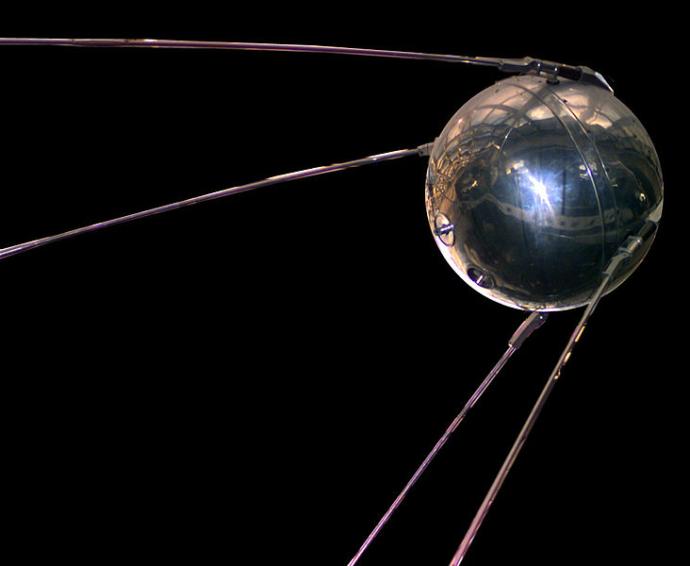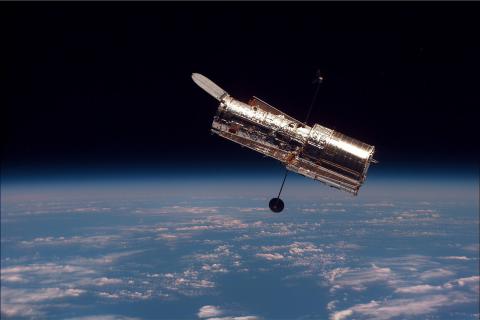A satellite is an object which orbits another. An orbit is the curved path an object in space takes around another.
Earth is a natural satellite of the Sun because it orbits the Sun. The Moon is a natural satellite of the Earth because it orbits the Earth.
On this page, when we use the word satellite, we mean human-made machines.

The first satellite was Sputnik, launched by Russia in 1957. It was in space for 3 weeks before its batteries died.
Today, thousands of satellites orbit the Earth. Most are 2,000 km to 36,000 km above the Earth. They travel at speeds of up to 8 km per second.
The size of a satellite depends on what it is used for. The smallest kind of satellite is only 10 cm wide. These cube sats send information or gather data. The largest satellite (the ISS) is the size of a football pitch. It is big enough for 6 or 7 crew to live and work inside. You sometimes see satellites in the sky at night.

- How Satellites Work and What They Do?
Satellites contain two main parts. They have an antenna which sends and collects information from Earth. They also have a part that powers the equipment on board. This is either a solar panel (that collects energy from the Sun) or a battery. Many also contain cameras and science equipment.
Satellites are useful in lots of ways. They let us send information around the world and help us navigate. Most of the craft which orbit the Earth study and solve problems for our own planet. They send and collect information over large areas, which makes them very efficient. But space stations, like the ISS, and space telescopes are also satellites.
Humans have also made satellites which orbit the Moon and other planets. They send data and images back to Earth using radio waves. So satellites let us study our Solar System and the Universe, as well as Earth.
- Types of Orbits and Satellite Safety
Satellites orbit the Earth along two main paths. We call these paths geostationary orbits and polar orbits.
A satellite in a geostationary orbit looks like it stays in the same place above the Earth. This lets it keep a watch on the area of the planet under it. The craft does this by moving at the same rate and in the same direction as the Earth. It makes 1 orbit of the Earth every 23 hours, 56 minutes and 4 seconds and travels west to east. A satellite must be 35,786 km above the Earth's equator to do this.
A satellite in a polar orbit travels in a north-south direction. This means it travels over the North and South poles of the Earth. As the Earth spins, the craft scans the entire globe, 1 strip at a time. Some of them pass over the same part of Earth at the same time each day. They can take a photo of a location each time they pass. Scientists use the images to compare how a place changes over long amounts of time.
Today, there are thousands of craft orbiting the Earth, but collisions are rare. This is because space agencies plan the orbits of their satellites to avoid other craft. But space agencies must keep track of their machines because orbits can change over time. In February 2009, two satellites - one American and one Russian - collided in space. This is thought to be the first time two craft collided in orbit.
Image CreditThis work by NASA is licensed under Creative Commons Zero v1.0 Universal
CreditThis work by NASA is licensed under Creative Commons Zero v1.0 UniversalThe Hubble Space Telescope - Can I see satellites from Earth?
Yes! You can see satellites for the same reason we can see the Moon and planets – they reflect light from the Sun.
- What can I see?
The International Space Station (ISS) is the biggest artificial satellite orbiting the Earth. It’s also the brightest. Its brightness varies depending on how much sunlight it reflects. Sometimes it looks as bright as the planet Venus!
When you spot the ISS, it looks like a star moving as fast as an aeroplane. The ISS travels at over 27,000 km per hour and orbits the Earth 15 times a day. The ISS has been in orbit since 1998 and usually has six astronauts on board, from all over the world.
The company SpaceX started launching Starlink satellites in May 2019. The Starlink project aims to provide internet across the whole world by using over 12,000 satellites. The Starlink satellites are launched in batches arranged in a chain. When a batch is first released, the satellites are close together. This makes it easy to spot them parading in a line across the sky. Over time, they drift apart and are harder to spot. Many astronomers worry light pollution from satellites could make it harder to observe objects in space. SpaceX made some changes to their satellites to try and reduce their brightness.
Image CreditThis work by NASA/Crew of STS-132 is licensed under Creative Commons Zero v1.0 Universal
CreditThis work by NASA/Crew of STS-132 is licensed under Creative Commons Zero v1.0 UniversalInternational Space Station - How do I spot them?
You can visit spot the station to find out when and where you can next see the International Space Station. This website helps you find Starlink. Many astronomy apps and software include options to help you spot artificial satellites. For example Heavens Above or Stellarium.
